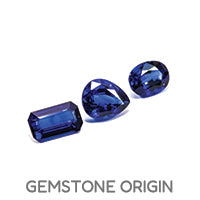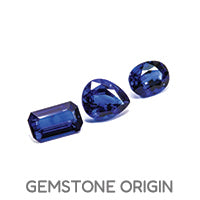Lab-Grown Ruby
Lab-grown rubies are created in a controlled laboratory environment using a process known as the flame fusion method or Verneuil process. This method involves melting fine powdered ruby crystal, composed of aluminum oxide, with traces of chromium (which give rubies their red color), in a high-temperature flame. As the molten material cools down, it crystallizes, forming a synthetic ruby.
Lab-grown rubies possess the same chemical, physical, and optical properties as natural rubies. They are visually and chemically identical to their mined counterparts, exhibiting the distinctive red color that rubies are famous for. Due to the controlled conditions in which they are created, lab-grown rubies often have fewer inclusions and imperfections than natural rubies, making them highly desirable for jewelry.
These lab-grown rubies offer an ethical and sustainable alternative to natural rubies, as they are produced without the environmental and ethical concerns associated with traditional mining. They are widely used in jewelry, allowing consumers to enjoy the beauty of rubies while making an environmentally conscious choice.
Lab-Grown emerald
Lab-grown emeralds, like lab-grown diamonds, are created in controlled laboratory environments using advanced scientific techniques. These emeralds are produced using a method called hydrothermal synthesis, which mimics the natural conditions under which emeralds are formed deep within the Earth's crust.
In the hydrothermal process, a solution of natural emerald elements is heated under controlled conditions, allowing the emerald crystals to grow over a period of time. The resulting lab-grown emeralds are chemically, physically, and optically identical to natural emeralds. They possess the same vibrant green color, clarity characteristics, and overall appearance as their mined counterparts.
Lab-grown emeralds offer several advantages, including ethical and environmental considerations. They are produced without the environmental impact and social concerns associated with traditional emerald mining. Additionally, they provide a sustainable and responsible alternative for those who are conscious of the environmental and ethical issues related to the gemstone industry.
These lab-grown emeralds are used in various jewelry designs, offering consumers an ethical choice when it comes to adorning themselves with this precious green gemstone.
Lab-Grown Blue Sapphire
Lab-grown blue sapphire, also known as synthetic or cultured blue sapphire, is a type of blue sapphire that is created in a laboratory setting rather than being formed naturally in the Earth's crust. These lab-grown sapphires have the same physical, chemical, and optical properties as natural blue sapphires. They are created through a process called "hydrothermal synthesis" or the "flux method," where scientists replicate the conditions under which natural sapphires are formed, leading to the growth of sapphire crystals.
Lab-grown blue sapphires are created using advanced technology to produce gem-quality stones that are visually identical to natural blue sapphires. They are often used in jewelry as a more affordable and ethical alternative to natural sapphires, as they do not involve the environmental impact and ethical concerns associated with mining.
It's important to note that lab-grown blue sapphires should be disclosed as synthetic or lab-created when sold in the market. Advanced gemological techniques are used to distinguish between natural and lab-grown sapphires, ensuring consumers are aware of the origin of the gemstone they are purchasing.
Lab-Grown Yellow Sapphire
Lab-grown yellow sapphire, also known as synthetic or cultured yellow sapphire, is a type of yellow sapphire that is created in a controlled laboratory environment rather than being formed naturally in the Earth's crust. Like lab-grown blue sapphires, these synthetic yellow sapphires have the same physical, chemical, and optical properties as natural yellow sapphires. They are created using advanced techniques that replicate the conditions under which natural sapphires are formed, leading to the growth of sapphire crystals with a yellow color.
Lab-grown yellow sapphires are popular in the jewelry industry as they provide an ethical and more affordable alternative to natural yellow sapphires. They offer consumers the opportunity to own a beautiful and durable gemstone without the environmental impact associated with mining.
Similar to other lab-grown gemstones, it is important for sellers to disclose that the yellow sapphire is synthetic when it is sold in the market. Gemologists can use various techniques to differentiate between natural and lab-grown yellow sapphires, ensuring transparency and clarity for consumers.
Lab-Grown Pink Sapphire
Lab-grown pink sapphire, also known as synthetic or cultured pink sapphire, is a type of pink sapphire that is created in a laboratory setting rather than being formed naturally in the Earth's crust. These lab-grown pink sapphires are made using advanced techniques that replicate the conditions under which natural sapphires are formed, resulting in the growth of sapphire crystals with a pink color.
Lab-grown pink sapphires have the same physical, chemical, and optical properties as natural pink sapphires, making them visually and chemically identical to their natural counterparts. They are popular in the jewelry industry as they offer an ethical and more affordable alternative to natural pink sapphires. These lab-created gemstones provide consumers with the opportunity to own a beautiful and durable pink sapphire without the environmental impact associated with mining.
When selling lab-grown pink sapphire in the market, it is important for sellers to disclose that the gemstone is synthetic. Gemologists can use various techniques to differentiate between natural and lab-grown pink sapphires, ensuring transparency and honesty in the gemstone market.
Lab-Grown Padparadscha Sapphire
Lab-grown Padparadscha Sapphire is a synthetic version of the rare and valuable natural Padparadscha Sapphire. Padparadscha Sapphire is a special variety of corundum, the same mineral that forms rubies and sapphires. What makes Padparadscha Sapphires unique is their beautiful pink-orange to salmon color, which is often described as a blend of pink and orange, reminiscent of the color of a lotus flower.
Lab-grown Padparadscha Sapphires are created in a controlled laboratory environment using advanced techniques such as the Verneuil process or the Czochralski process. These methods allow scientists to mimic the natural conditions under which sapphires are formed, resulting in gemstones that are chemically, physically, and optically identical to natural Padparadscha Sapphires.
One of the advantages of lab-grown Padparadscha Sapphires is that they are typically more affordable than their natural counterparts, making this rare and beautiful gemstone more accessible to a wider range of consumers. Additionally, lab-grown gems are ethically sourced and do not involve the environmental and social concerns associated with some natural gemstone mining practices.
Lab-Grown Alexandrite
Lab-grown Alexandrite is a synthetic version of the natural gemstone Alexandrite. Alexandrite is a variety of chrysoberyl, a mineral consisting of beryllium aluminum oxide. What sets Alexandrite apart is its unique ability to change color under different lighting conditions. It appears green in natural or fluorescent light and can shift to red or purplish-red under incandescent light.
In a laboratory setting, scientists are able to create synthetic Alexandrite using various methods, such as the Flux or Czochralski processes. These techniques replicate the natural conditions under which Alexandrite is formed, resulting in gemstones that possess the same chemical, physical, and optical properties as natural Alexandrite.
Lab-grown Alexandrite offers several advantages. Firstly, it is often more affordable than natural Alexandrite, making it accessible to a broader range of consumers. Secondly, the availability of lab-grown Alexandrite reduces the demand for mining natural Alexandrite, which can be scarce and expensive. Additionally, synthetic Alexandrite is an ethical and environmentally friendly choice, as it does not contribute to the depletion of natural resources or involve the environmental and social issues associated with some mining practices.
The development of lab-grown Alexandrite has allowed more people to enjoy this fascinating and rare gemstone without the hefty price tag often associated with its natural counterpart.























































































































